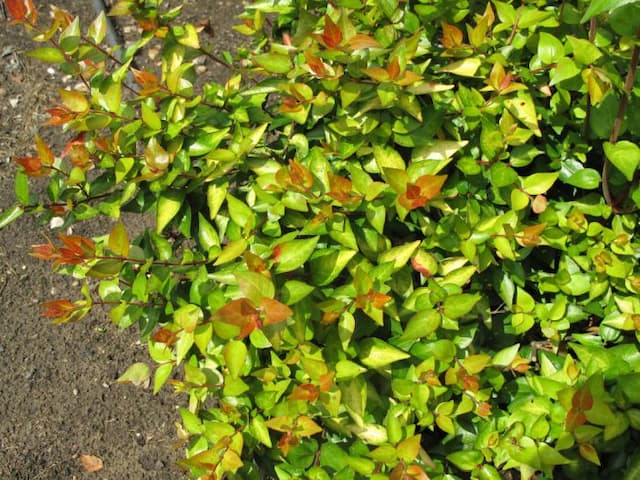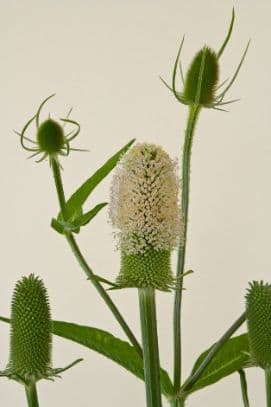Golden lace Patrinia triloba

ABOUT
Patrinia triloba, commonly known as Golden Lace, presents a lush and textured visage in the garden. This plant is characterized by its deeply cut, lobed leaves which create a backdrop of intricate greenery throughout the growing season. The foliage tends to be bright to mid-green, forming a mounded shape. Come late summer or early autumn, Golden Lace produces an impressive display of flower panicles that are airy and delicate. These clusters of tiny, star-like flowers are often a soft yellow or golden color, which adds a warm and inviting touch to its surroundings. The individual blossoms are arrayed in loose, open sprays, giving an effect of a mist of color hovering above the foliage. The blooms not only add a visual appeal but also attract a variety of pollinators to the garden, including bees and butterflies. After flowering, seed heads may form, providing additional texture and interest into the later season. Golden Lace is a plant that effortlessly combines both foliage and floral interest, making it a versatile and attractive addition to any planting scheme that seeks to create a naturalistic or cottage garden aesthetic. Its leaves and flowers both contribute to its charm, making it a plant that can be appreciated for multiple seasons throughout its growth cycle.
About this plant
 Names
NamesSynonyms
Golden Lace, Golden Valerian
Common names
Nardostachys triloba, Patrinia scabiosaefolia.
 Toxicity
ToxicityTo humans
Patrinia triloba, commonly known as golden lace, does not have a widely recognized reputation for being toxic to humans. However, the lack of well-documented cases or research means that the possibility of toxicity or allergic reactions cannot be entirely ruled out. It's always recommended to exercise caution and avoid ingesting parts of any plant unless it is known to be safe for consumption. If one were to ingest Patrinia triloba and experience unusual symptoms, it would be advisable to seek medical attention.
To pets
Golden lace, or Patrinia triloba, is not commonly listed among plants that are known to be toxic to pets. While it is unlikely to cause severe poisoning, the ingestion of any non-food plant can potentially cause gastrointestinal upset in pets, such as vomiting or diarrhea. As with humans, detailed information on the plant's toxicity to pets is limited, so it is advisable to prevent pets from ingesting the plant and to consult a veterinarian if any symptoms arise following ingestion.
 Characteristics
CharacteristicsLife cycle
Perennials
Foliage type
Deciduous
Color of leaves
Green
Flower color
Yellow
Height
2-3 feet (0.6-0.9 meters)
Spread
2 feet (0.6 meters)
Plant type
Herb
Hardiness zones
5
Native area
Asia
Benefits
 General Benefits
General Benefits- Ornamental Value: Adds aesthetic appeal to gardens with its bright yellow flowers and distinctive foliage.
- Attracts Pollinators: Provides nectar and habitat for bees and other beneficial insects, supporting biodiversity.
- Low Maintenance: Patrinia triloba is known for being easy to care for, requiring minimal upkeep once established.
- Drought Tolerance: The plant has a good tolerance for dry conditions, making it suitable for xeriscaping.
- Soil Adaptability: It can adapt to a range of soil types, provided they are well-drained.
- Fast Growth: Exhibits relatively quick growth, allowing gardeners to establish plantings in a shorter period of time.
- Deer Resistance: Less appealing to deer, which can help prevent damage to the garden.
 Medical Properties
Medical Properties- Anti-inflammatory: Patrinia triloba may possess properties that help reduce inflammation.
- Antibacterial: There is evidence that suggests the plant has antibacterial effects against certain bacterial strains.
- Antioxidant: The compounds in Patrinia triloba may act as antioxidants, helping to neutralize free radicals in the body.
- Hepatoprotective: The plant may offer some protective effects for the liver, potentially aiding in maintaining liver health.
- Immune system support: Patrinia triloba might have effects that support and enhance the immune system.
 Air-purifying Qualities
Air-purifying QualitiesThis plant is not specifically known for air purifying qualities.
 Other Uses
Other UsesPatrinia triloba, commonly known as golden lace, can be used as a natural dye for fabrics, imparting a soft yellow hue when the flowers are processed and applied to textiles.
The leaves of the golden lace may be used in compost as a green layer, adding nitrogen and enhancing the decomposition process of organic matter.
In horticulture, golden lace can be used as a trap crop, attracting pests away from more valuable plants in a garden or agricultural setting.
The dried stalks and flowers of Patrinia triloba provide a source of material for traditional handicrafts, often used in rural areas to create rustic home decorations.
The nectar-rich flowers of golden lace can serve to increase biodiversity by attracting and supporting populations of beneficial insects such as lacewings and ladybugs.
Golden lace can be planted as a companion plant, possibly deterring certain pests through its scent or other natural properties, thus protecting neighboring crops.
Patrinia triloba's dense foliage offers a natural shelter for small wildlife, such as birds and beneficial insects, creating a microhabitat within gardens and landscapes.
The plant can be used in floristry for its distinctive golden flower heads, providing a unique aesthetic to floral arrangements and bouquets.
When used as ground cover, golden lace can prevent soil erosion on slopes and banks, thanks to its root system that helps stabilize the ground.
The seeds of Patrinia triloba can be collected and used as an educational tool to teach children about the life cycle of plants and the basics of gardening.
Interesting Facts
 Feng Shui
Feng ShuiThe Patrinia is not used in Feng Shui practice.
 Zodiac Sign Compitability
Zodiac Sign CompitabilityThe Patrinia is not used in astrology practice.
 Plant Symbolism
Plant Symbolism- Resilience: Patrinia triloba, commonly known as Golden Lace, is a plant that thrives in a variety of soil conditions and signifies the ability to withstand difficult situations.
- Beauty in Simplicity: Golden Lace showcases modest yellow-white flowers, representing the idea that there is beauty in simplicity.
- Healing: In some cultures, parts of the Golden Lace are used in traditional medicine, symbolizing healing and restoration of health.
- Good Fortune: The vibrant blooms of the Golden Lace are often associated with good luck and prosperity in one's life.
 Water
WaterGolden Lace, also known as Patrinia triloba, prefers evenly moist soil and should be watered thoroughly once the top inch of the soil starts to dry out, which is typically once a week. However, the frequency of watering may vary depending on the climate and weather conditions—less often in humid and cooler conditions, and more frequently in dry and hot environments. During the active growing season in spring and summer, Golden Lace may need water every few days, but always check the soil moisture level first. A good practice is to provide about 1 gallon of water to the plant's base, ensuring deep soil penetration and avoiding overhead watering to prevent leaf diseases.
 Light
LightGolden Lace thrives best in an area of the garden that receives full sun to part shade conditions. A spot with morning sunlight and afternoon shade or dappled sun throughout the day is ideal for promoting healthy growth and flowering. Avoid deep shade locations, as insufficient light can lead to poor flowering and a leggy plant.
 Temperature
TemperatureGolden Lace fares well in a wide range of temperatures and is hardy in temperate regions. It can survive temperatures as low as 20 degrees Fahrenheit and as high as 90 degrees Fahrenheit, though its ideal temperature range is between 60 and 75 degrees Fahrenheit. Protecting the plant from extreme cold by using mulch can help ensure its longevity through winter.
 Pruning
PruningPruning Golden Lace should be done to remove spent flowers and encourage additional blooming throughout the season. Cut back the flower stems after the blooms have faded, and in late winter or early spring, prune the plant to remove any dead or damaged stems. This maintenance helps to keep the plant looking tidy and promotes healthy growth. The best time for more thorough pruning is after the last frost, to shape the plant and prepare it for the growing season.
 Cleaning
CleaningAs needed
 Soil
SoilThe best soil mix for Golden Lace should be well-draining, loamy, and rich in organic matter with a pH range of 5.5 to 7.0. A mix of two parts garden soil, one part peat moss or coconut coir, and one part perlite or coarse sand is ideal to provide the necessary drainage and aeration. Incorporating compost will enhance fertility and water retention.
 Repotting
RepottingGolden Lace rarely needs repotting as it's a herbaceous perennial that dies back each winter. You should divide the plant every 3 to 4 years in early spring to maintain its health and control its spread rather than repotting.
 Humidity & Misting
Humidity & MistingGolden Lace thrives in average humidity conditions typically found outdoors. No specific humidity requirements are necessary for this plant, as it is quite adaptable. Just ensure it is not placed in an extremely arid environment to avoid stress.
 Suitable locations
Suitable locationsIndoor
Ensure bright indirect light, maintain moderate humidity, and good airflow.
Outdoor
Plant in partial shade to full sun, in well-draining soil.
Hardiness zone
5-8 USDA
 Life cycle
Life cyclePatrinia triloba, commonly known as "Golden Lace," begins its life cycle as a seed that germinates in late winter or early spring, depending on the climate. Upon germination, it develops a small rosette of leaves at the soil surface. As it grows, the rosette becomes larger, and the plant establishes a strong root system. In late spring to early summer, Patrinia triloba produces tall stems that bear clusters of small, star-shaped yellow flowers that are attractive to pollinators. After pollination, the flowers develop into seed capsules, which release seeds when mature, typically in late summer or early fall. The plant may then die back, depending on the climate, and lie dormant over the winter, completing its life cycle.
 Propogation
PropogationPropogation time
Spring-early summer
Propogation: The most popular method of propagating Patrinia triloba, commonly known as Golden Lace, is through seed. To propagate by seed, it is essential to sow them in late winter to early spring. The seeds require pre-chilling for a few weeks before sowing, which simulates the natural stratification process they would undergo in the wild. This can be done by mixing the seeds with moist sand and placing them in a plastic bag in the refrigerator, which maintains temperature between 35-40°F (1.6-4.4°C). After chilling, seeds should be sown on the surface of a well-draining seed starting mix, as they need light to germinate. The container should be kept in a warm location, around 68°F (20°C), and the soil must remain moist until germination, which typically occurs within a few weeks. Seedlings can be transplanted outdoors after the last frost once they are sufficiently grown.








